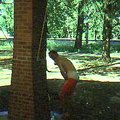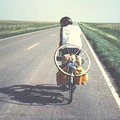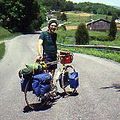Editor's note: Every spring a whole new crop of bicycling fans are champing at the bit to take their first bicycle tour. While most have already read the standard “Top 10 tips” of bicycle touring somewhere, here are my personal suggestions gleaned from hard-learned lessons.
This is a reprint of a post buried in the bowels of my blog from several years ago. Most pointers are still true today:
I remember reading some how-to articles about bicycle touring before my friend Bruce and I took off on our cross-country bicycle trip in 1984. Quite a few things I didn't learn until we got out on the road and talked to other cyclists or bike hosts, like the Cookie Lady or Lazy Louie, or experienced first hand.
Here are my suggestions you might not always find in a how-to bike tour book:
 1. Keep clean, especially your most tender parts. Cycling shorts are a heated petri dish for bacteria. Even if you're camping at a spot without showers, find a water spigot or head into a restroom to give yourself a good cleaning down below. A small pimple or rash can become an infection to rival anything found in the trenches of World War I. We talked to a couple who had to stop their tour the previous year because of such an infection.
1. Keep clean, especially your most tender parts. Cycling shorts are a heated petri dish for bacteria. Even if you're camping at a spot without showers, find a water spigot or head into a restroom to give yourself a good cleaning down below. A small pimple or rash can become an infection to rival anything found in the trenches of World War I. We talked to a couple who had to stop their tour the previous year because of such an infection.
2. Don't be a slave to mileage. Let's face it, we all have goals about how many miles we want to average on the trip. Remember, it's an average. The first week of a long-distance bicycle tour is your last week of training. Take it slow and short. Those 40-mile days the first week will double — or triple — once you hit the Great Plains.
3. Learn how to camp. I know some people like staying in motels, but aside from being expensive, it cuts you off from other folks. You'll meet lots of people at campgrounds, including other bicycle tourists, and get to swap lots of stories. Same with camping in city parks. I always felt isolated in a motel and spent my time staring at the TV. Also, it's harder to get going in the morning. It's always seems colder, hotter, or wetter when you first hit the road until your body adjusts to being outdoors again.
4. It goes without saying that you'll have to fix flats. Carry extra tubes, but get proficient at patching as well. In some cases, I was able to pull off the road, set the bike on its side and find the puncture, pop that section of the tire from the rim, and patch the tube. Easier than taking off the wheel to replace the tube. Better yet, invest in a good set of kevlar tires or use “Mr. Tuffy” liners. They might add a little weight, but the time you save by not having to fix flats is well worth it.
5.  Learn how to replace spokes. The rear wheel takes a lot of stress from panniers and your rear end sitting over the back wheel, as well as the tension from pedaling on hills. You'll need to true-up your wheel if a spoke breaks and then re-true it when you thread that new spoke in at night. (More advice from Ken Kifer's excellent bicycle touring website.)
Learn how to replace spokes. The rear wheel takes a lot of stress from panniers and your rear end sitting over the back wheel, as well as the tension from pedaling on hills. You'll need to true-up your wheel if a spoke breaks and then re-true it when you thread that new spoke in at night. (More advice from Ken Kifer's excellent bicycle touring website.)
6. Other minor fixits. Learn how to adjust the brakes and gears as cables stretch. Take a small repair manual — I used Tom Cuthbertson's Anybody's Bike Book, but that was 20-plus years ago. There are components on bikes now — drum brakes, fer instance, or brifters — that he didn't dream of then.
7. Make a plan for the day. We always started the day with a plan, even though it often changed during the day. With a target, it's easier to make adjustments as you go along instead of starting from scratch when you're all bleary-eyed.
8. Keep a journal and take a camera. In the short term you'll be amazed at how your mileage increases as your trip progresses. In the long term, it gives you something to show your grandkids… or publish on your blog. Everyone takes a camera, and I wish we had the small digital shooters that we can use now. I'd recommend bringing a couple of extra memory cards. I took more than 400 slides, but looking back, I wish I would have taken a picture of every campsite, motel, or home where we stayed. It would vividly show how the landscape changed as we progressed cross-country.
9. Food and drink. You know the adage “drink before you're thirsty” and “eat before you're hungry.” We rode through some places where the heavy taste of the water would just about gag us, especially after sitting in the water bottle for a while. Back then, bottled water wasn't available in every roadside country store. It probably is now. Also, find alternatives to the space-age snacks you might eat on a weekend ride, unless you have a big budget. Really, we're mainly talking carbs and calories here and snacks like fig newtons, etc. have plenty. At one-pot evening meals, I found elbow macaroni packed plenty of bang for the buck.
Food and drink. You know the adage “drink before you're thirsty” and “eat before you're hungry.” We rode through some places where the heavy taste of the water would just about gag us, especially after sitting in the water bottle for a while. Back then, bottled water wasn't available in every roadside country store. It probably is now. Also, find alternatives to the space-age snacks you might eat on a weekend ride, unless you have a big budget. Really, we're mainly talking carbs and calories here and snacks like fig newtons, etc. have plenty. At one-pot evening meals, I found elbow macaroni packed plenty of bang for the buck.
10. Too much stuff. Pack only what you really need. Then, after you struggle up some mountain slopes, stop at the first small community you get to, find a cardboard box and a post office, and mail home what you don't want to lug up every hill for the remaining miles of your bike tour.

1 comments
Good blog. That was tough work – much, much harder than we don’t learned. Thanks!